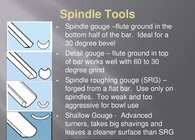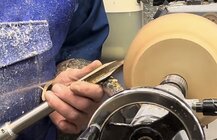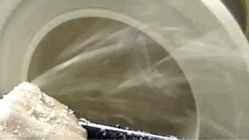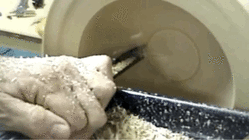What do we think?
-
December 2025 Turning Challenge: Single Tree! (click here for details) -
Congratulations to Bob Henrickson, People's Choice in the November 2025 Turning Challenge (click here for details) -
Congratulations to Guillaume Fontaine for "Old Tea Pot" being selected as Turning of the Week for December 15, 2025 (click here for details) -
Welcome new registering member. Your username must be your real First and Last name (for example: John Doe). "Screen names" and "handles" are not allowed and your registration will be deleted if you don't use your real name. Also, do not use all caps nor all lower case.
You are using an out of date browser. It may not display this or other websites correctly.
You should upgrade or use an alternative browser.
You should upgrade or use an alternative browser.
Spowl Gouge?
- Thread starter Bill Alston
- Start date
Seems effective for him. Basically a 3/8 flute in a bigger bar I think. Lots of grinding, would certainly be stable.
john lucas
AAW Forum Expert
Very much like my Thompson 1/2" bowl gouge with a V flute. Don't know if Doug makes a 5/8 or 3/4 with a V I'll have to look.
Hmm, don't think I will get one. I just don't use the swept back type gouges at all any more. 40/40 and BOB gouges only. Some times detail gouges on spindles.
robo hippy
robo hippy
- Joined
- Apr 27, 2004
- Messages
- 9,306
- Likes
- 6,061
- Location
- Lakeland, Florida
- Website
- www.hockenberywoodturning.com
I'd have to get good at sharpening freehand--Wouldn't fit in my Wolvering jig.
- Joined
- Apr 27, 2004
- Messages
- 9,306
- Likes
- 6,061
- Location
- Lakeland, Florida
- Website
- www.hockenberywoodturning.com
Grinding away the top of the bar is an attribute of a spindle gouge.An interesting point is that the top of the gouge has been ground flat.
Leaving the flat shows the difference in the bar diameter from the flute diameter.
He said he had a 22 mm bar that is 7/8 - typical diameter of a 3/4” bowls gouge.
He shows having a 3/8” gouge nose on a 7/8” bar
Lots of comparisons.
3/8” gouge tend to cut cleaner than 1/2”
7/8” bars vibrate less than 5/8” bars and less than 1/2” bars
3/8” gouges take smaller shavings than 1/2” gouges.

For me it would be a solution looking for a problem, but it may meet a need in others like it has for him.
What I applaud is that he has experimented with making his own gouges to meet his needs and this is how experienced woodturners have collectively improved our tools over the last 50yrs or so that I have been turning.
Woodturners will endlessly play around with gouge grinds, but seem quite adverse to venturing into making or altering the flute profile on their gouges. It is not difficult to do and I have posted about that on the forum...
 www.aawforum.org
www.aawforum.org
 www.aawforum.org
www.aawforum.org
If you are looking for rigidity rather than weight in your gouges then short flutes provide that. For myself I don't want all that extra weight in the gouges that he has shown in his video. At my age I get tired enough after a session in the workshop without adding a gym workout at the same time!
Also, with CBN wheels that take off so little steel when resharpening a gouge we don't need the long flutes to get a useful life from a gouge that is made from a full length piece of HSS. With CBN and short flutes they are going to last a long time before they need to be replaced and if you have a batch of DIY gouge tips in your tool rack for different purposes you are unlikely to get to the point where you will have to be replacing or extending many of them.
Of course, this is not something for the novice turner who doesn't yet know what they don't know, but something that experienced turners could do if they are inclined that way and who knows what new and significant improvement may come out of our experimentation.
I look forward to seeing what you come up with.
What I applaud is that he has experimented with making his own gouges to meet his needs and this is how experienced woodturners have collectively improved our tools over the last 50yrs or so that I have been turning.
Woodturners will endlessly play around with gouge grinds, but seem quite adverse to venturing into making or altering the flute profile on their gouges. It is not difficult to do and I have posted about that on the forum...
DIY bowl gouges and flutes
Not many of us have the necessary expertise or the heat treatment setup to make our own bowl gouges from annealed HSS bar stock, but most of us would have or could readily obtain the necessary means for making our own bowl gouges from ready to use bar stock. Why DIY? a more affordable way to...
Grinding short flutes to make new bowl gouges
This thread is a companion to one that I have added to the main discussion forum. This one is how I went about it while the other one covers the background and the results of my efforts. That other thread in the main discussion forum is titled DIY bowl gouges and flutes. Prior to now the method...
If you are looking for rigidity rather than weight in your gouges then short flutes provide that. For myself I don't want all that extra weight in the gouges that he has shown in his video. At my age I get tired enough after a session in the workshop without adding a gym workout at the same time!
Also, with CBN wheels that take off so little steel when resharpening a gouge we don't need the long flutes to get a useful life from a gouge that is made from a full length piece of HSS. With CBN and short flutes they are going to last a long time before they need to be replaced and if you have a batch of DIY gouge tips in your tool rack for different purposes you are unlikely to get to the point where you will have to be replacing or extending many of them.
Of course, this is not something for the novice turner who doesn't yet know what they don't know, but something that experienced turners could do if they are inclined that way and who knows what new and significant improvement may come out of our experimentation.
I look forward to seeing what you come up with.
My turning experience is with automatic lathes, now with CNC, in the past with pattern copying lathes or with lathes using cutters made in the shape of the part. I imagine shaped cutters are still the most widely used in production turning in the furniture industry. Shaped cutters seemed to have somewhat fallen out of favor due to the cutter expense and difficulty to manufacture because of the versatility of CNC even though it's slower.Of course, this is not something for the novice turner who doesn't yet know what they don't know, but something that experienced turners could do if they are inclined that way and who knows what new and significant improvement may come out of our experimentation.
The ultimate woodturning cutters were developed decades ago. The same cutter can be used in bowl turning as for spindles and they cut as well against the grain as with it. The necessity of these cutters were to produce parts needing very little sanding. In the past these cutters were ground from HSS, now they are available as carbide inserts. Ornament turners use these type cutters where the cutter is pattern guided with no sanding. The issue for hand turners is the difficulty in controlling these cutters because of their free cutting and tendency to self feed causing catches. Hooded, depth limiting methods have been tried. Hunter carbide tools tilt the insert a bit to downplay the cutter's aggressiveness.
It's fascinating to me that a whole industry has sprung up involving sharpening systems, specialty gouges for different uses, exotic tool steels, CBN wheels not to mention those individuals who make a good part of their income teaching usage of traditional, primitive gouges.
My observations:
1- if I were to personify the wood fibers, they'd likely say that they don't give a hoot about any aspect of the woodturning industry we support and encourage except for 2 things: the inclusive angle of the flute/bevel, and the quality of the two-demensional line where the interior flute and exterior bevel meet. That's a patch of steel about 1/8" square to not more than 1/4" square. Everything else, everything, is there to satisfy the human being in some subjective way. Brand, alloy, size, overall shape... pretty much meaningless after the inclusive angle is set and the 2 plains meet at a keen edge. Turners cranking out a hundred bowls per day with sharpened scrap leaf springs prove this every day.
2- this fellow has WAY too many tools. Show-off. Early on, he reached 7' above the floor for a caliper. Now that he has his dream tools, everything else should immediately be donated to local trade schools.
3- he's launching wood waste all over his tool wall storage system. That must be a bear to keep clean, unless Bill Murray in "Caddyshack" is his inspiration.
4- I sure hope he never stumbles backward into his unprotected roughing gouge collection. That would be most unfortunate.
1- if I were to personify the wood fibers, they'd likely say that they don't give a hoot about any aspect of the woodturning industry we support and encourage except for 2 things: the inclusive angle of the flute/bevel, and the quality of the two-demensional line where the interior flute and exterior bevel meet. That's a patch of steel about 1/8" square to not more than 1/4" square. Everything else, everything, is there to satisfy the human being in some subjective way. Brand, alloy, size, overall shape... pretty much meaningless after the inclusive angle is set and the 2 plains meet at a keen edge. Turners cranking out a hundred bowls per day with sharpened scrap leaf springs prove this every day.
2- this fellow has WAY too many tools. Show-off. Early on, he reached 7' above the floor for a caliper. Now that he has his dream tools, everything else should immediately be donated to local trade schools.
3- he's launching wood waste all over his tool wall storage system. That must be a bear to keep clean, unless Bill Murray in "Caddyshack" is his inspiration.
4- I sure hope he never stumbles backward into his unprotected roughing gouge collection. That would be most unfortunate.
Looks like a solution looking for a problem. But he clearly felt there was a problem that needed solving. He obviously likes collecting tools and presumably saw this as a fun project. I know if I buy one more tool I’ll become an expert but in the meantime I’ll try to use those I have, better!
Glen makes and sells his own tools. I suspect when he has an idea for a new tool he makes one.My observations:
2- this fellow has WAY too many tools. Show-off. Early on, he reached 7' above the floor for a caliper. Now that he has his dream tools, everything else should immediately be donated to local trade schools.
I also have lots of home made tools. If one doesn’t seem to work any better than anything else I don’t throw it away it just goes on the shelf. Unlike Glen though I don’t make handles for all my tools, I use interchangeable handles.
Glens website just for interest, he doesn’t ship outside the UK.
Our Carbide Wood Turning Tools are hand crafted and are economical priced and are ideal for pen and bowl turners alike
Our Carbide Wood Turning Tools are hand crafted and are economical priced and are ideal for pen and bowl turners alike
Looks interesting, I agree with the idea its a solution looking for an issue. But if it works for you, thats fine, and I think its a case of horse for courses.
Alternately, I can achieve great stiffness with a harden shaft and a Woodcut type tip, so the diameter would be as a conventional gouge along with the weight . But to adding to that, if you buy a tip off Woodcut NZ and fit it into a same dia bar made of 316 stainless steel, you should have a very stiff tool. How stiff? Well, good enough to turn a hollow vessel in most Aussie hardwoods. Half of my hollowing tools have 316 shafts the size range would be 16mm, 19 and 20mm
Alternately, I can achieve great stiffness with a harden shaft and a Woodcut type tip, so the diameter would be as a conventional gouge along with the weight . But to adding to that, if you buy a tip off Woodcut NZ and fit it into a same dia bar made of 316 stainless steel, you should have a very stiff tool. How stiff? Well, good enough to turn a hollow vessel in most Aussie hardwoods. Half of my hollowing tools have 316 shafts the size range would be 16mm, 19 and 20mm
It's fascinating to me that a whole industry has sprung up involving sharpening systems, specialty gouges for different uses, exotic tool steels, CBN wheels not to mention those individuals who make a good part of their income teaching usage of traditional, primitive gouges.
Yes, Doug, and that's because it's more fun to do than machine turning!
Yes, Doug, and that's because it's more fun to do than machine turning!
Aye.



